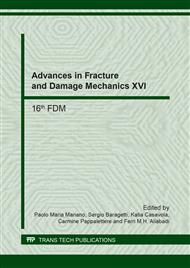p.27
p.31
p.35
p.39
p.43
p.47
p.51
p.55
p.59
Fatigue Crack Growth in an Al-Mg-Si Alloy under Negative Load Ratio
Abstract:
The usual approaches for Fatigue Crack Growth (FCG) assessment are based on semi-empirical models that consider the stress intensity factor range of fracture mechanics, ΔK, as the governing driving force for crack propagation. However, FCG data incorporating compressive loads have brought discussions and controversies. The compressive loads are not taken into account in the usual life prediction codes and the negative portion of the loading cycle is neglected. In the present work, constant amplitude fatigue crack growth tests with load ratios-1 and 0 are performed, for two diferent stess levels, in AA 6005 alloy centre-notched middle tension M(T) specimens and the obtained results are discussed. It is shown that the crack closure concept, that usually work well for positive ratios, is not enough to satisfactorily explain the negative load ratio effects. The results also showed how the negative part of the load affected the propagation rate of the crack, mainly for larger cracks and smaller loads. Finally, it is shown that a previously proposed expression for the stress distribution ahead of the crack can shed some light on this question.
Info:
Periodical:
Pages:
43-46
Citation:
Online since:
September 2017
Price:
Сopyright:
© 2017 Trans Tech Publications Ltd. All Rights Reserved
Share:
Citation:


